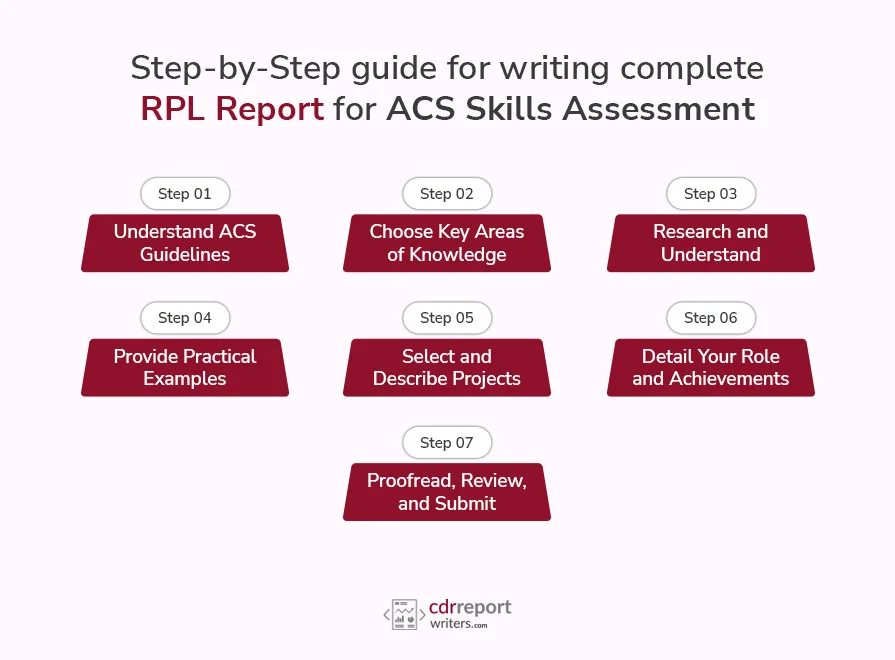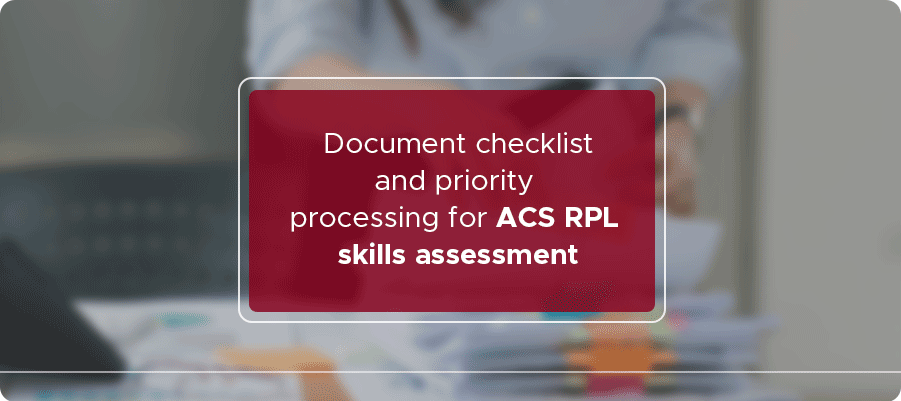
How to write complete RPL for ACS skills assessment?
For IT professionals seeking to migrate to Australia, the Australian Computer Society (ACS) skills assessment is a crucial step. The Recognition of Prior Learning (RPL) report is a significant component of this assessment process.
The RPL report allows candidates with non-ICT qualifications or insufficient ICT experience to prove their skills and competencies. This comprehensive guide will walk you through the process of writing a successful RPL for ACS skills assessment.
What is the RPL Report?
The RPL report is vital for ACS skills assessment, particularly if you lack ICT qualifications. It enables you to showcase your practical skills and knowledge, bridging the gap between formal qualifications and required expertise.
This section of the ACS application is essential for demonstrating your industry know-how, even without formal qualifications. To navigate the RPL, it’s crucial to comprehend its structure and significance.
Components of the RPL Report
The RPL report consists of two parts:
1. Key Areas of Knowledge
In this segment, applicants are required to address two project-related topics from a predetermined list. These topics cover critical ICT areas such as networking, databases, security, and more. The aim is to assess the candidate’s theoretical understanding of these concepts.
This part checks how well you understand important ICT topics. Even if you don’t have official qualifications, your work experience could have given you insights into these areas. The ACS assessors want to see how much you know about basic concepts and how they connect to your real work.
When talking about these key areas, it’s important to explain things. This shows that you can use what you’ve learned in real-life situations. So, make sure your explanations are clear and complete. This way, the assessors can see how well you can use your theoretical knowledge in practical settings.
2. Project Reports
The crucial part of the RPL for ACS skills assessment, this section necessitates describing two projects you have participated in. For each project, you should outline your role, the project’s objectives, your responsibilities, the challenges encountered, and the outcomes achieved. This part assesses your practical skills and their application in real-world scenarios.
Crucial Elements of Project Reports
The project reports offer a platform to display your practical ICT skills. The ACS assessors gets interested in your application of knowledge, problem-solving prowess, and your contribution to successful project outcomes. As you describe each project, consider the following:
- Project Selection: Choose projects that best align with your ICT skills and experience. These could be from your professional career, academic pursuits, or even personal undertakings.
- Role and Responsibilities: Showcase your role in each project. Describe your responsibilities, including any challenges you faced, and how you addressed them.
- Technical Details: Elaborate on the technical aspects of the projects. Discuss the tools, technologies, programming languages, and software you utilized. Highlighting your familiarity with these technical components is essential.
- Impact and Outcomes: Delve into the impact your contributions had on the projects. Did they achieve the desired outcomes? How did your involvement influence the project’s success?
Learn More: How to Write an ACS RPL Report for Database Administrator? ✈️✈️
Documenting Your RPL Report
ACS has specific guidelines for the RPL for ACS skills assessment format. Follow them:
- Write in clear, concise English. Use technical terms, but ensure your writing is understandable to a non-technical audience.
- Your RPL for ACS skills assessment must be your work. Plagiarism can lead to rejection.
- Organize your report with clear headings and subheadings. Use a consistent font and format throughout.
- Stick to the word count limit provided by ACS. Be concise while providing comprehensive information.
- Proofread your report for grammar and spelling errors.
Step-by-Step guide for writing complete RPL Report for ACS Skills Assessment
Below is the step-by-step guide for writing a complete RPL Report for ACS skills assessment:

1. Understand ACS Guidelines
Begin by comprehending the ACS guidelines for the RPL for ACS skills assessment. This includes understanding the required structure, format, and content expectations. Familiarize yourself with the specific key areas of knowledge and project-related topics you need to address.
2. Choose Key Areas of Knowledge
Select two key areas of knowledge from the provided list that align with your experience. These areas are pivotal in assessing your theoretical understanding of critical ICT concepts.
3. Research and Understand
Delve into each chosen key area of knowledge. Research and understand the underlying theoretical concepts. This step ensures you have a strong foundation for the practical application to get showcased later.
4. Provide Practical Examples
For each key area of knowledge, provide practical examples from your experience that show your application of these theoretical concepts. These examples should showcase how you’ve used your theoretical understanding in real-world situations.
5. Select and Describe Projects
Choose two projects that best exemplify your ICT skills and expertise. These projects should be relevant to the key areas of knowledge you’ve chosen. Provide comprehensive descriptions of these projects, including objectives, roles, and challenges.
6. Detail Your Role and Achievements
Within each project description, outline your responsibilities, tasks performed, and the technical challenges you encountered. Emphasize your problem-solving skills and innovation in overcoming these challenges. Quantify your achievements whenever possible to showcase the impact of your contributions.
7. Proofread, Review, and Submit
Proofread your entire RPL for ACS skills assessment mainly for grammar, spelling, and coherence. Review ACS sample RPLs to ensure you’re adhering to the expected quality and depth. Seek feedback from peers or mentors if possible. Finally, submit your completed RPL for the ACS skills assessment along with the necessary documents within the stipulated deadline.
Following these seven steps, ICT professionals can make a good RPL report that shows off their ICT skills and what they know to the ACS people. Each step makes your report better. It follows the ACS rules and tells a good story of how you went from learning stuff to doing real things with technology.
So, if you follow these steps, your report will be strong and clear, and it will show that you’re good at using what you’ve learned in the tech world.
Learn More: How to prepare CPD for your CDR Report? 🧑🏽✈️🏆
Tips for writing an RPL for ACS Skills Assessment
Making a good Recognition of Prior Learning (RPL) report for an Australian Computer Society (ACS) skills test might feel hard but don’t worry. If you plan well, look at the details, and know what they want, you can make a good RPL. This will show how good you are at stuff and what you’ve done before.
Remember, even if it looks tough if you take it step by step and put in the effort, your RPL for ACS skills assessment can be amazing and show everyone how skilled you are. Here are some essential tips to ensure your RPL stands out and increases your chances of a positive skills assessment outcome:
- ACS values authenticity. Represent your skills, experience, and accomplishments. Exaggeration or misrepresentation can lead to negative consequences, so ensure your RPL for ACS skills assessment remains a genuine reflection of your capabilities.
- Understand the ACS requirements for the RPL report for ACS skills assessment. Address all aspects of the criteria, including key areas of knowledge and detailed project descriptions. Ensure your responses are comprehensive and aligned with the guidelines.
- When describing your experience and skills, provide specific examples and instances that highlight your expertise. Tangible examples provide evidence of your practical knowledge and prove your ability to apply skills in real-world scenarios.
- In the project reports section, emphasize your contributions to the projects. Outline your responsibilities, the challenges you faced, and how your actions influenced the project’s success clearly.
- Whenever possible, quantify your achievements. Use metrics, percentages, or data to showcase the impact of your work. This provides a clearer understanding of the value you bring to a project or organization.
- Many ICT projects involve troubleshooting and problem-solving. Narrate instances where you resolved challenges, showcasing your analytical thinking and innovative problem-solving skills.
- Write in a clear, concise, and organized manner. Avoid jargon that might be unfamiliar to non-technical readers. Effective communication enhances the readability of your RPL for ACS skills assessment.
- After writing your RPL, proofread it for grammatical errors, spelling mistakes, and formatting inconsistencies to prevent RPL rejection. A polished and error-free document reflects your attention to detail and professionalism.
- The ACS website often provides sample RPLs. Review these samples to understand the level of detail, language, and structure expected by ACS assessors. But, avoid copying these samples; your RPL should be unique to your experiences.
- Before submitting your RPL for ACS skills assessment, consider seeking feedback from colleagues, mentors, or professionals who gets experienced in writing technical documents. Their insights can help refine your content and enhance its quality.
- Ensure you submit your RPL well before the deadline. This gives you ample time for any revisions or corrections that might be necessary.
- Maintain a clear structure in your RPL for ACS skills assessment. Use headings, bullet points, and paragraphs to make the content easy to read and understand. A well-organized RPL enhances its impact.
Learn More: Can an Engineering technologist get a PR Visa? ⏱⌛️
Why Choose Us?
CDRReportWriters is your trusted partner for a seamless Competency Demonstration Report (CDR) journey. Our seasoned engineering experts tailor CDRs to Engineers Australia standards, reflecting your unique strengths. Our quality assurance ensures error-free reports, meet language, and formatting criteria.
With technical skills, we convey your engineering prowess. We adhere to guidelines, creating original reports and delivering them. Transparent communication keeps you involved throughout the process. Our successful track record speaks volumes. Choose us for a polished, original, and timely CDR that paves the way for your Australian engineering dreams.
Conclusion
Writing a successful RPL for ACS skills assessment is crucial for IT professionals looking to migrate to Australia. The report allows you to showcase your knowledge and experience, even if you lack formal qualifications. By addressing the key areas of knowledge and providing detailed project reports, you can present a compelling case for your skills.
Remember to follow ACS guidelines for migration skills assessment, be honest, and be thorough in your descriptions. A well-crafted RPL can enhance your chances of a successful skills assessment and, your journey to a rewarding career in Australia.





